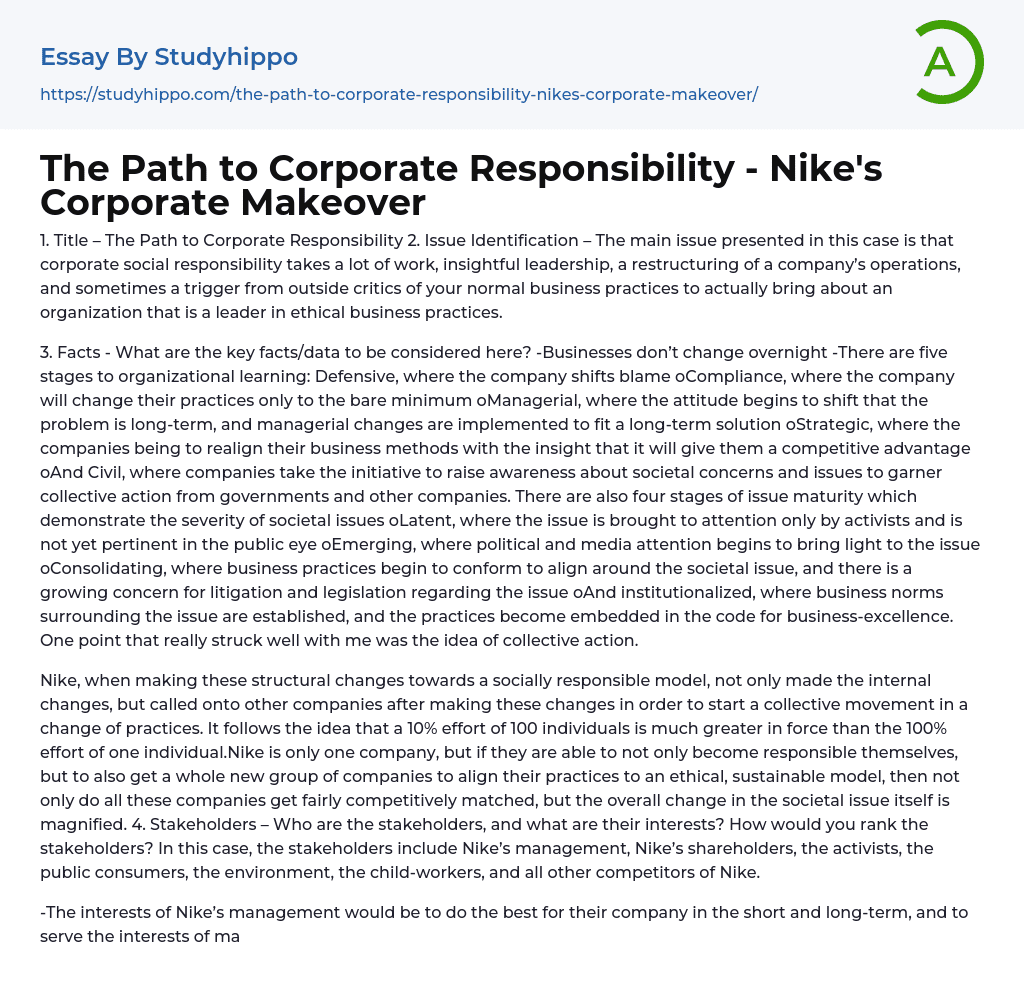

The Path to Corporate Responsibility – Nike’s Corporate Makeover Essay Example
1. The title of the article is "The Path to Corporate Responsibility". 2. The essential problem raised is that becoming a corporate socially responsible entity requires significant effort, astute leadership, a reconfiguration of business operations, and possibly a push from external critics to establish an ethical business model.
3. In terms of essential information to consider, it is important to note that businesses do not transform instantaneously. There are five phases of organizational learning that may occur: Defensive, where blame is shifted; Compliance, where practices are altered minimally; Managerial, where a long-term solution is sought and implemented via managerial shifts; Strategic, where business practices are realigned in order to obtain a competitive advantage; and Civil, where companies address societal issues to encourage collective action from both the government and other businesses. Moreover, there are f
...our steps in issue maturity that highlight the seriousness of societal concerns: Latent stage, when the issue is merely noted by activists and unimportant publically; Emerging stage, where political and media attention begins to draw attention to the problem at hand; Consolidating stage, when business practices begin to conform around the societal issue, with growing concern for lawsuits and legislation surrounding it; and Institutionalized stage, where guidelines concerning the matter have been established within the business code of excellence. Lastly, the notion of collective action resonated with me deeply.
Nike took action to become a socially responsible company, and not only made internal changes, but also encouraged other companies to follow suit in order to create a collective movement towards ethical and sustainable practices. The idea is that the efforts of many individuals are more powerful than one individual's full effort
By inspiring other companies to adopt responsible practices, Nike aims to level the playing field and amplify the positive impact on societal issues. The stakeholders in this case include Nike's management and shareholders, activists, public consumers, the environment, child-workers, and competitors. Each stakeholder has their own interests, but they are all affected by Nike's actions towards social responsibility.
The interests of Nike’s management are to prioritize the company's success in the short and long run, as well as to maximize profits for shareholders. Meanwhile, activists are motivated by a desire to address social issues, while consumers seek affordable shoes from companies practicing responsible business ethics. Child-workers, on the other hand, are interested in earning money while residing in safe living conditions and receiving wages above subsistence. As for Nike's competitors, their interests may lie in purely seeking profit or upholding responsible business practices.
My stakeholder ranking places management at the top due to the potential long-term harm a wrong move could cause the company. Shareholders closely follow due to their investment. However, it's crucial that environmental and child-worker interests align with activist concerns and not be ignored, in addition to shareholder interests. Public consumer interests significantly influence Nike management's decisions. Competitors are not direct stakeholders and have no direct impact on this matter. Recommendations regarding the issue have already been presented.
Through its sustained efforts, Nike has successfully transitioned into a sustainable and socially responsible organization. Although the transformation required significant time and resources, the company's pioneering efforts in this field are now yielding dividends. By serving as an industry leader, Nike is inspiring other companies to follow suit and raising awareness about social issues to foster collective
action towards positive change.
- Board Of Directors essays
- Brand Management essays
- Business Ethics essays
- Business Management essays
- Change Management essays
- Comparative Analysis essays
- Decision Making essays
- Dispute Resolution essays
- Knowledge Management essays
- Leadership essays
- Leadership and Management essays
- Manager essays
- Operations Management essays
- Performance Management essays
- Product Management essays
- Project Management essays
- Quality Management essays
- Risk essays
- Risk Management essays
- Scientific Management essays
- Stress Management essays
- supply chain management essays
- Time Management essays
- Total Quality Management essays
- Accounting essays
- Andrew Carnegie essays
- Automation essays
- Business Cycle essays
- Business Intelligence essays
- Business Model essays
- Business Operations essays
- Business Software essays
- Cooperation essays
- Cooperative essays
- Corporate Social Responsibility essays
- Corporation essays
- Customer Relationship Management essays
- Family Business essays
- Franchising essays
- Harvard Business School essays
- Harvard university essays
- Human Resource Management essays
- Infrastructure essays
- Inventory essays
- Logistics essays
- Management essays
- Manufacturing essays
- Market essays
- Marketing essays
- Multinational Corporation essays



